
|
Sale 58
Manuscript, Collectibles and Aerospace Auction
| Lot |
Photo |
Description |
Realized |
Lot 71 |
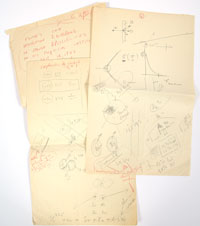 |
Berg, Morris "Moe" & Paul Scherrer. Berg (1902-1972) was an American Major League Baseball catcher who also served as a spy for the United States. A graduate of Princeton, he spoke a dozen languages and was often said to be the smartest man to ever play baseball. Paul Scherrer (1890-1969) was a Swiss physicist, specializing in nuclear physics. Historic diagrams, mathematical equations, and notes by American spy Moe Berg and Swiss physicist Paul Scherrer describing an atomic chain reaction which occurred less than eight months later in Hiroshima and Nagasaki, 14 x 9 in., recto/verso, Zurich, December 26, 1944. Notes by Moe Berg (code name "Remus") in red pencil, by Dr. Paul Scherrer (code name "Flute"), director of physics at the Federal Institute of Technology in Zurich, in regular pencil. Expert restoration to fraying on cover page at top and right edges. Fine condition.
The article "Scholar, Lawyer, Catcher, Spy" by Nicholas Dawidoff in "Sports Illustrated," March 23, 1992, says, in part: " … The day after Christmas [1944], at Flute�s laboratory in Zurich, Flute spent hours diagramming atomic chain reactions. Then Remus took the pencil, sketched a diamond and proceeded to explain the American sport of baseball…. Flute didn�t keep that sketch. Remus took it and, perhaps, sent it off to Washington with Flute�s scribbled formulas. Such was Remus's obligation, and Flute understood that anything he told Remus might well end up on President Roosevelt�s desk in the White House…."
"Wild Bill" Donovan, the father of the OSS, initially recruited Berg because of his linguistic skills. Berg was given a variety of assignments in Italy, Switzerland and Sweden, but his most significant work was in atomic counterintelligence. Donovan and Lt. Gen. Leslie Groves, head of the Manhattan Project, wanted confirmation that Hitler�s scientists were nowhere near completion of an atomic bomb. Berg immersed himself in nuclear physics, and in 1944, attended a lecture in Zurich by the leading German atomic scientist, Werner Heisenberg, with orders to kidnap or assassinate Heisenberg if Berg could determine that a German atomic bomb project was impending. A recently declassified memo written in 1946 by Colonel Howard Dix to recommend Berg for the Medal of Freedom says that Berg�s attendance at the meeting �yielded the most important information snatched from under the cloak of secrecy which the Germans maintained on this subject. This and other information sent back by Mr. Berg and obtained by him while under continual risk of exposure and retaliatory action, was used in guiding, the U.S. operation in this field and in determining … the pressures to be placed upon U.S. scientists for rapid progress towards ultimate completion of the Manhattan Project.�" In 1994, Dawidoff�s biography of Berg was published by Pantheon Books, "The Catcher Was a Spy: The Mysterious Life of Moe Berg."
These are some of the diagrams the two agents drew, with notes by Berg. In the upper portion of the cover page, Moe Berg has written in red pencil "Zurich 26/XII/44. Flute�s own description & diagrams of Azusa & possibilities at his Physical Institution December 26, 1944. � my notes in red Flutes in black." Berg then circled what he had written. Project Azusa was the code name of the secret mission assigned to Berg by the OSS.
On the first page, numbered in the upper right by Berg with a circled "1" in red, headed by Berg "(explanation of content of U)." The symbol for Uranium is U. Its atomic number is 92 and atomic weight is 238.02891. Scherrer has circled in regular pencil "+ 92," underlined "238" and written "~100%." Beneath this, he�s circled another "+92" and penciled "235" and "1/140." Scherrer has drawn a rectangle around this line and written a third line of a circled "+92," "234" and "1/10000." Uranium 239 first decays into Neptunium 239, further decaying into Plutonium 239. Scheerer has drawn a diagram in the center of the page, labeling "U 239" and drawing a box around the name "Nier." Alfred O. C. Nier was the first to separate Uranium 235 from Uranium 238. He joined other scientists in proving that U 235 was a source of nuclear energy when uranium is bombarded with slow neutrons. Berg has identified "Nier who followed up on Hahn & Strassman � importance of U 235." In the lower third of the page, Scherrer has drawn and labeled diagrams and, at the lower edge, has written "U 235 + n = Sr + Xe + 2-3 n," circling the final "n" and drawing an arrow to it labeled "chain reaction." Berg has also written "chain reaction." "Sr" is the symbol for Strontium and "Xe" for Xenon. Scherrer has also written "Ba" for Barium and "Kr" for Krypton.
The next five pages have drawings and mathematical equations ostensibly diagramming atomic chain reactions with "Mass-Spectrograph," "fission," "Thorium," and "rendement" (French for "production, yield") in Scherrer�s hand. Berg has written "Thorium" above Scherrer�s "Thorium." Above Scherrer�s drawing of what resembles a coil, Berg has written "explanation of role of Cadmium layers of alternation U235 & cadmium." Berg has labeled one of Scherrer�s diagrams "aerodynamics another subject" and identified two of Scherrer�s words as "Prandle" and "Exterman of Geneva." Thorium, written by both Berg and Scherrer, is a source of nuclear power.
Less than eight months after the physicist Scherrer and the spy Berg wrote and explained in detail atomic chain reactions on these pages, a U-235 bomb destroyed Hiroshima and a Plutonium bomb destroyed Nagasaki, in effect, ending World War II.
Estimated Value $6,000 - 8,000.
View details and enlarged photo
| Unsold |
Lot 72 |
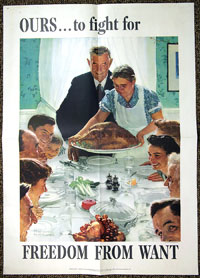 |
Four Freedoms - Two Vintage Posters, 1943. Two of Norman Rockwell's ''Four Freedoms'' posters: "Freedom of Speech" and "Freedom From Want," measuring 28' x 20 in. each. Light age toning and original fold lines; each has some pin marks in upper corners from previous use. The "Freedom of Speech" poster has "Buy War Bonds" in the lower border and is OWI [Office of War Information] Poster No. 44; "Freedom From Want" is OWI Poster No. 45. These scenes, along with those in "Freedom of Worship" and "Freedom from Fear," were painted by Rockwell for the Saturday Evening Post, in which they appeared on March 6, 1943. Rockwell got the idea for the paintings from a speech given by President Franklin D. Roosevelt on January 6, 1941. The Treasury Department used the images to promote war bonds. Rockwell's favorite was "Freedom of Speech."
Estimated Value $600 - 800.
View details and enlarged photo
| Unsold |
Lot 73 |
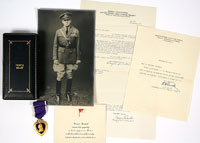 |
MacArthur, Douglas (1880-1964) During World War II, he commanded U.S. Army forces in the Far East. When he lost the Philippines, he promised "I shall return,"and on October 20, 1944, the first day of the decisive two month allied victory in the Battle of Leyte, he waded ashore on Palo Beach. An archive pertaining to Gilbert T. Richards, a 21-year-old millwright living in Knox County, Maine, who enlisted as a Private in the U.S. Army Air Corps in Augusta, Maine, on November 25, 1941. When Major Gen. Edward P. King, Jr. surrendered more than 75,000 American and Filipino troops to the Japanese, the prisoners were forced to march 61 miles north to San Fernando. About 54,000 prisoners arrived at Camp O�Donnell by May 1st; many, however, died along the way of exhaustion or starvation or were wantonly killed by their captors. Private Gilbert T. Richards survived the march but died from malaria on May 19, 1942, at Camp O�Donnell and was buried on Luzon.
The archive consists of four letters, a printed sympathy card, a Purple Heart, and an early signed photo of MacArthur:
(1) Douglas A. MacArthur. Typed Letter Signed "Douglas MacArthur," one page, 10½ x 8 in. To Harry C. Richards, Camden, Maine. On letterhead "General Headquarters / United States Army Forces, Pacific / Office of the Commander-in-Chief," APO 500, 13 October 1945. Vertical folds. Fine condition. In full, "My deepest sympathy goes to you in the death of your son, Private Gilbert T. Richards, while a prisoner of war of the enemy. You may have some consolation in the memory that he, along with his comrades-in-arms who died on Bataan and Corregidor and in prison camps, gave his life for his country. It was largely their magnificent courage and sacrifices which stopped the enemy in the Philippines and gave us the time to arm ourselves for our return to the Philippines and the final defeat of Japan. Their names will be enshrined on our country�s glory forever. In your son�s death I have lost a gallant comrade and mourn with you. Very faithfully…"
(2) Margaret Chase Smith. Typed Letter Signed "Margaret Smith" as Maine Congresswoman, one page, 10½ x 8 in. Washington, December 11, 1941. On congressional stationery, to Mr. and Mrs. Harry C. Richards, Camden, Maine, just four days after Pearl Harbor. Evidently, Pvt. Richards� parents knew he was on a ship in the Pacific but did not know exactly where. In part: "My sympathy is with you and I wish so much I could get the information you want but both because of the uncertainty of affairs in the Pacific and the need to keep locations of troops away from the enemy, the Departments will not give out any information as to the movements or location of ships…. " Fine condition.
(3) Henry H. "Hap" Arnold. War-date Typed Letter Signed "H H Arnold" as Commanding General, Army Air Forces. To Mr, and Mrs. Richards. Washington, D.C., Memorial Day, 1945. In full, "We are again mindful on this Memorial Day of our debt to those of the Army Air Forces who have given their lives for our Country. Their memory is always with us." With original postmarked envelope, Torn at top edge, missing back flap. Fine condition. Gen. Hap Arnold was promoted to five-star General of the Army by Pres. Franklin D. Roosevelt in 1944 and five-star General of the Air Force in 1949 by Pres. Harry S Truman, becoming the only officer to attain five-star rank in two of the Armed Forces.
(4) R.E. Gambrill. Typed Letter Signed "R.E. Gambrill" as Major, Assistant Adjutant General, one page, 10½ x 8 in. General Headquarters, United States Army Forces, Pacific, APO 500, October 8, 1945. To Harry C. Richards, Camden, Maine. In part, "Permit me to extend to you my heartfelt sympathy for the loss of your son, Private Gilbert T. Richards, 11016707, who died on the 19th of May, 1942, from malaria at Camp O�Donnell, Philippine Islands, while a prisoner of war of the Japanese.Anything I can say is scant consolation to you in your grief. It is my fervent hope that later, the knowledge that his courage and sacrifice contributed to the final victory may be of sustaining comfort to you." Fine condition.
(5) [George C. Marshall]. Printed card, 4¼ x 5¼ in. With original envelope, "The Chief of Staff / War Department / Washington, D.C.," 5½ x 4½ in., cut open at right edge. Postmarked Washington, D.C., September 1, 1945. To Harry C. Richards, Camden. Maine. Engraved in red and gold at top center with his five star flag and engraved message: "General Marshall / extends deep sympathy / in the loss of your son. He died / in the honorable service of his country / to preserve the freedom under which he lived." Fine condition.
(6) Purple Heart in original 6½ x 3½ x 1¼ in. clamshell box. In the shape of a rich purple heart bordered with gold, a bust of George Washington in the center and Washington�s coat of arms at the top. Engraved on verso: "For / Military / Merit." With purple ribbon and bar. Since posthumous awards are always engraved with the soldier�s name beneath the inscription, and this one isn't, this is most probably a replacement award. On June 3, 1944, Secretary of War Henry L. Stimson wrote, in a typed letter to Harry C. Richards, in part, "The President has requested me to inform you that the Purple Heart has been awarded posthumously to your son, Private Gilbert T. Richards, Air Corps, who sacrificed his life in defense of his country…" A very small photocopy of this letter is included.
(7) Douglas MacArthur Black & White Photograph Signed, 9¾ x 6 in., no date, no place. Early photo shows silvering along edges. Large signature across boots in dark area with fair contrast. Mounting remnants on verso. Fine.
Estimated Value $4,000 - 6,000.
View details and enlarged photo
| Unsold |
Lot 74 |
 |
McAuliffe, Anthony Clement (1898-1975) General, U.S. Army. In December 1944, due to the absence of General Maxwell D. Taylor, he was commanding the 101st Airborne Division and other attached troops at Bastogne, Belgium during Germany's last, desperate offense, known as the Battle of the Bulge. When his command was surrounded and the German commander, Generalleutnant Heinrich Freiherr von Lütwitz, sent a written demand for surrender in order to avoid "total annihilation," McAuliffe sent back a one-word reply, "Nuts," which became the most famous quote of World War II. Autograph quote and signature, "Nuts / AC McAuliffe," on a 2 x 3½ in. card, n.p., n.d. Fine. Penned in blue ink.
Estimated Value $1,000 - 1,500.
View details and enlarged photo
| Realized
$376 |
Lot 75 |
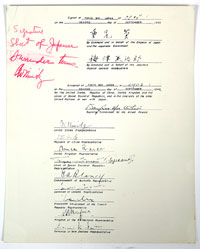 |
Nimitz, Chester W (1885-1966) Commander of U.S. Pacific Fleet in World War II. Historic Document Signed "CW Nimitz," 2pp, 10 x 8 in., separate sheets, n.p., n.d. Photostatic copy of the first page headed "Instrument of Surrender." Photograph of the second page beginning "Signed at Tokyo Bay, Japan at 09 04 on the Second day of September, 1945…" signed by Fleet Admiral Nimitz in red ink: "Signature / Sheet of Japanese / Surrender terms / CW Nimitz." Nimitz had originally repeated the word "Signature," then erased it, replacing it with "Surrender." Accepting the surrender "at 0908" in a ceremony aboard the U.S.S. "Missouri" in Tokyo Bay was Gen. Douglas MacArthur. Japanese Foreign Minister Mamoru Shigemitsu and Chief the Imperial Japanese Army General Staff Yoshijiro Umezu surrendered "By Command and in behalf of the Emperor of Japan and the Japanese Government" and "By Command and in behalf of the Japanese Imperial General Headquarters" respectively. The signatures of MacArthur, Shigemitsu, and Umezu, and representatives of the United States (Nimitz), China, United Kingdom, U.S.S.R., Australia, Canada, France, Netherlands, and New Zealand are depicted on the photograph. Fine condition. An excellent World War II memento.
Estimated Value $3,000 - 4,000.
View details and enlarged photo
| Realized
$2,938 |
Lot 76 |
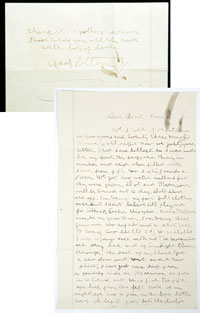 |
Patton, George (1885-1945) American general and tank commander; called "Old Blood and Guts. Very early Autograph Letter Signed "Geo S. Patton Jr.," 1½pp, recto/verso, 12 x 8 in. (Lake Vinyard, California, circa late 1890s). To Aunt Nannie, his mother's sister. Ink stains, folds. Fine condition. In full, "We start for Catilena in two hours and twenty three minutes. Mama is all right now; we just got your letter. I had some ballast sacks made for my boat, the sacks are thirty in number and weigh when filled with sand from fifty two sixty pounds a piece. We got two water mellons but they were green. Dot and Marmion [Patton's horse] will be turned out to day. Dot�s shews are off. I am taking my foot ball clothes over but I don�t believe I�ll play; nor go to Hick Cocks this year. Harrie Mellon may be on your train, I am taking three guns two rifeles and a shot gun 77 twenty two shells 20; 30-30 shells. Lance is going over with us. The mosquitoes are very bad and often bight clean through the soul of my shoes. I got a new dres suit vest and a new shirt, I have just come back from a good-by ride on Marmion before he is turned out he is fine. The fifth eye-lash from the left-side of my right eye has a pain in the little toe of its left foot but the doctor thinks it is nothing serious. I have tolde you all the news. With lots of love…"
George�s father had bought land and built a cottage on Santa Catalina Island in early 1895. The Pattons would go by buggy from their home to Long Beach where they would board the boat to the island, about 20 miles off the coast of southern California. Although young Patton could not spell very well, it is obvious from this letter that he loved Catalina, since he was counting the minutes until they left. It is also obvious that he was already a sportsman and owned a veritable arsenal of weapons.
Estimated Value $2,000 - 2,500.
View details and enlarged photo
| Realized
$1,880 |
Lot 77 |
 |
World War II - Two Original, Vintage British Posters. Two famous British posters, both quite collectible:
1. Recruitment poster for the Auxiliary Territorial Service (ATS), by Abram Games, November 194, printed by James Haworth & Brother Ltd, London, 28½ x 19 in. Top center has a 1½ in. tear at fold. Printed in two shades of red. A fresh-faced young woman gazes upward. The ATS was the women's branch of the army; by July 1942, some 217,000 women had joined.
2. "Women of Britain Come Into the Factories," by Philip Zec, probably 1941, printed by Lowe and Brydone, London, 29¼ x 19¼ in. A young woman reaches joyously to the sky as planes she has helped build fly on their way to defeat the Germans. Small split at top (½ in.) and a couple of tiny edge tears.
Estimated Value $600 - 800.
View details and enlarged photo
| Realized
$390 |
|
|